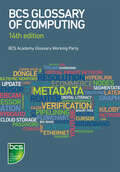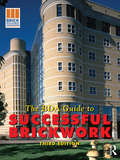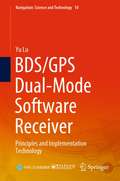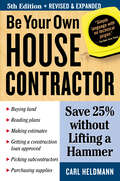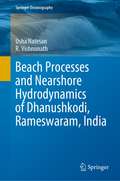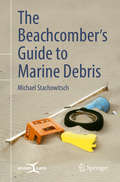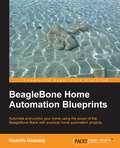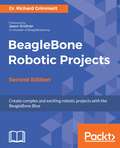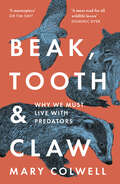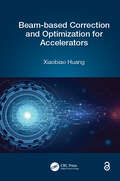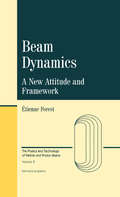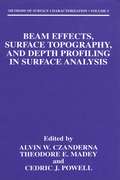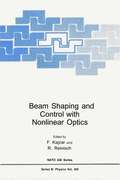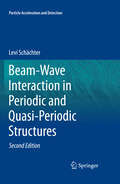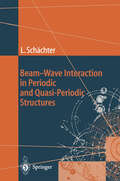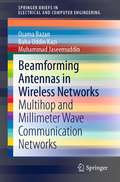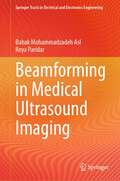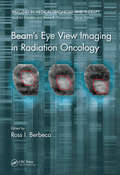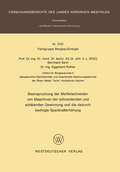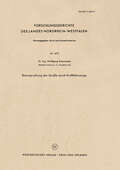- Table View
- List View
BCS Glossary of Computing
by David Fuller Adrian Jackson John Woollard Thomas Ng Penny Patterson Marianne Scheer Hazel Shaw Alfred Vella Arnold Burdett Dan Bowen Diana Butler Aline Cumming Frank Hurvid John Jaworski Percy MettThe BCS Glossary is the most authoritative and comprehensive work of its kind. This unrivalled study aid and reference tool has newly updated entries and is divided into themed sections making it more than just a list of definitions. Written in an easily accessible style, it is specifically designed to support those taking computer courses or courses where computers are used, including GCSE, A-Level and 14-19 Functional Skills qualifications in schools and further education colleges.
BDA Guide to Successful Brickwork
by The Brick Development AssociationThe BDA Guide to Successful Brickwork is the definitive practical guide to obtaining successful results in brickwork construction. Written by a team of experts from the Brick Development Association, the representative group in industry for brickwork construction, this best-selling text has now been brought fully in line with the latest British and European Standards, including the requirements of the new European Standard for Bricks EN771-1, to ensure readers are receiving the most up-to-date and accurate information available in the field.Based on actual teaching practice, the book is highly illustrated throughout to increase accessibility of the text for the reader in its exploration of the practical aspects of brickwork. It also includes an extensive glossary of brickwork terms for ease of reference. The third edition contains new material detailing recent innovations in brickwork, in the areas of components, systems and techniques, which includes the development of thin-joint techniques for both brickwork and blockwork.Students following NVQs and Construction Awards in Trowel Occupations (bricklaying route, at Foundation, Intermediate and Advanced level) from CITB, will find this book to be an invaluable source of information which will accompany them throughout their studies. The text has additional relevance to BTEC National and Higher Nationals in Construction, as well as GNVQ Intermediate and AVCE Construction and Built Environment courses. Building professionals concerned with the design, detailing and specification of brickwork will also find The BDA Guide to be an essential reference.
BDA Guide to Successful Brickwork
by The Brick Development AssociationThe BDA Guide to Successful Brickwork is the definitive practical guide to obtaining successful results in brickwork construction. Written by a team of experts from the Brick Development Association, the representative group in industry for brickwork construction, this best-selling text has now been brought fully in line with the latest British and European Standards, including the requirements of the new European Standard for Bricks EN771-1, to ensure readers are receiving the most up-to-date and accurate information available in the field.Based on actual teaching practice, the book is highly illustrated throughout to increase accessibility of the text for the reader in its exploration of the practical aspects of brickwork. It also includes an extensive glossary of brickwork terms for ease of reference. The third edition contains new material detailing recent innovations in brickwork, in the areas of components, systems and techniques, which includes the development of thin-joint techniques for both brickwork and blockwork.Students following NVQs and Construction Awards in Trowel Occupations (bricklaying route, at Foundation, Intermediate and Advanced level) from CITB, will find this book to be an invaluable source of information which will accompany them throughout their studies. The text has additional relevance to BTEC National and Higher Nationals in Construction, as well as GNVQ Intermediate and AVCE Construction and Built Environment courses. Building professionals concerned with the design, detailing and specification of brickwork will also find The BDA Guide to be an essential reference.
BDS/GPS Dual-Mode Software Receiver: Principles and Implementation Technology (Navigation: Science and Technology #10)
by Yu LuThis book introduces readers to the algorithm of Compass & GPS dual-system software receivers, and to the software implementation. It provides detailed descriptions of key theories in the fields of signal processing, communication, control, and signal estimation. The book is based on the author’s extensive experience in GNSS receiver design. The MATLAB script developed for this book demonstrates most of the key theories and equips the reader with excellent tools for practicing them.
Be Your Own House Contractor: Save 25% without Lifting a Hammer
by Carl HeldmannYou don&’t need to depend on (or pay) a general contractor to manage your construction project. Whether you&’re building a new home or renovating an existing one, you can manage the job yourself. Carl Heldmann outlines how to purchase your own land, set a reasonable budget and schedule, describe your needs and vision to an architect, and hire subcontractors to do the actual building. Cut out the middleman and save as much as 25 percent on your beautiful new home!
Beach Processes and Nearshore Hydrodynamics of Dhanushkodi, Rameswaram, India (Springer Oceanography)
by Usha Natesan R. VishnunathThis book focuses on understanding the shoreline dynamics, nearshore processes and sediment transport around Rameswaram Island and the cities of Dhanushkodi and Arichamunai. Rameswaram Island is located between the Gulf of Mannar on the south and Palk Bay on the north, between the southern tip of India and Sri Lanka, and is unique in terms of physical, chemical and biological processes. The Gulf of Mannar is established as a marine biodiversity conservation area by its richness of variety and variability of marine species such as corals, finfish, shellfish and other fishes. The island is predominantly influenced by four seasons: northeast monsoon, post-monsoon, summer and southwest monsoon; and the sedimentological and hydrodynamic conditions significantly change seasonally, resulting in the island’s responding in a different manner with each season. It also explains the physical forces and their impacts around these areas. Rameswaram Island has existed naturally for a long period of time even under the influence of different water masses of the Gulf of Mannar and Palk Bay. Understanding the regional natural phenomena is the only solution to carry out the best management practices to develop coastal constructions and modifications.
The Beachcomber’s Guide to Marine Debris
by Michael StachowitschThis richly illustrated book serves as the ideal guide to the items that litter the world’s beaches. Forget sea shells and other fauna and flora. Here, you will find what a beachcomber is actually most likely to encounter these days: glass, plastic, wood, metal, paper, oil, and other sources of marine pollution!Complete with nearly 700 photographs, this guide shows the full range of marine debris items, each presented with insight and a pinch of humor. In addition, the author provides full details about these items. You will learn everything worth knowing about them. This includes not just their sources and decomposition stages. Discover the threat each item poses to these beautiful environments as well as prevention strategies, clean-up recommendations, alternative products, and recycling and upcycling ideas.Beyond the aesthetic issue, marine debris poses a threat to wildlife, human health, and economic welfare. This book arms you with the knowledge you need to combat these disgraceful and often hazardous eyesores. Become a beach detective! Travel the world’s most beloved tourist destinations with this ultimate beach read and help restore these fascinating environments to their natural beauty.
BeagleBone Robotic Projects
by Richard GrimmettBeagleBone Blue is effectively a small, light, cheap computer in a similar vein to Raspberry Pi and Arduino. The new features of the BeagleBone Blue make it even easier to use in DIY robotics projects. This project guide provides step-by-step instructions that enable anyone to use this new, low cost platform in some fascinating robotics projects.
Beak, Tooth and Claw: Living With Predators In Britain
by Mary Colwell‘A must read for all wildlife lovers’ Dominic Dyer Foxes, buzzards, crows, badgers, weasels, seals, kites – Britain and Ireland’s predators are impressive and diverse and they capture our collective imagination. But many consider them to our competition, even our enemies.
Beam-based Correction and Optimization for Accelerators
by Xiaobiao HuangThis book provides systematic coverage of the beam-based techniques that accelerator physicists use to improve the performance of large particle accelerators, including synchrotrons and linacs. It begins by discussing the basic principles of accelerators, before exploring the various error sources in accelerators and their impact on the machine's performances. The book then demonstrates the latest developments of beam-based correction techniques that can be used to address such errors and covers the new and expanding area of beam-based optimization. This book is an ideal, accessible reference book for physicists working on accelerator design and operation, and for postgraduate studying accelerator physics. Features: Entirely self-contained, exploring the theoretic background, including algorithm descriptions, and providing application guidance Accompanied by source codes of the main algorithms and sample codes online Uses real-life accelerator problems to illustrate principles, enabling readers to apply techniques to their own problems Xiaobiao Huang is an accelerator physicist at the SLAC National Accelerator Laboratory at Stanford University, USA. He graduated from Tsinghua University with a Bachelor of Science in Physics and a Bachelor of Engineering in Computer Science in 1999. He earned a PhD in Accelerator Physics from Indiana University, Bloomington, Indiana, USA, in 2005. He spent three years on thesis research work at Fermi National Accelerator Laboratory from 2003-2005. He has worked at SLAC as a staff scientist since 2006. He became Accelerator Physics Group Leader of the SPEAR3 Division, Accelerator Directorate in 2015. His research work in accelerator physics ranges from beam dynamics, accelerator design, and accelerator modelling and simulation to beam based measurements, accelerator control, and accelerator optimization. He has taught several courses at US Particle Accelerator School (USPAS), including Beam Based Diagnostics, Accelerator Physics, Advanced Accelerator Physics, and Special Topics in Accelerator Physics.
Beam-based Correction and Optimization for Accelerators
by Xiaobiao HuangThis book provides systematic coverage of the beam-based techniques that accelerator physicists use to improve the performance of large particle accelerators, including synchrotrons and linacs. It begins by discussing the basic principles of accelerators, before exploring the various error sources in accelerators and their impact on the machine's performances. The book then demonstrates the latest developments of beam-based correction techniques that can be used to address such errors and covers the new and expanding area of beam-based optimization. This book is an ideal, accessible reference book for physicists working on accelerator design and operation, and for postgraduate studying accelerator physics. Features: Entirely self-contained, exploring the theoretic background, including algorithm descriptions, and providing application guidance Accompanied by source codes of the main algorithms and sample codes online Uses real-life accelerator problems to illustrate principles, enabling readers to apply techniques to their own problems Xiaobiao Huang is an accelerator physicist at the SLAC National Accelerator Laboratory at Stanford University, USA. He graduated from Tsinghua University with a Bachelor of Science in Physics and a Bachelor of Engineering in Computer Science in 1999. He earned a PhD in Accelerator Physics from Indiana University, Bloomington, Indiana, USA, in 2005. He spent three years on thesis research work at Fermi National Accelerator Laboratory from 2003-2005. He has worked at SLAC as a staff scientist since 2006. He became Accelerator Physics Group Leader of the SPEAR3 Division, Accelerator Directorate in 2015. His research work in accelerator physics ranges from beam dynamics, accelerator design, and accelerator modelling and simulation to beam based measurements, accelerator control, and accelerator optimization. He has taught several courses at US Particle Accelerator School (USPAS), including Beam Based Diagnostics, Accelerator Physics, Advanced Accelerator Physics, and Special Topics in Accelerator Physics.
Beam Dynamics
by Etienne ForestThis volume lays down the foundations of a theory of rings based on finite maps. The purpose of the ring is entirely discussed in terms of the global properties of the one-turn map. Proposing a theory of rings based on such maps, this work offers another perspective on storage ring theory.
Beam Dynamics
by Etienne ForestThis volume lays down the foundations of a theory of rings based on finite maps. The purpose of the ring is entirely discussed in terms of the global properties of the one-turn map. Proposing a theory of rings based on such maps, this work offers another perspective on storage ring theory.
Beam Effects, Surface Topography, and Depth Profiling in Surface Analysis (Methods of Surface Characterization #5)
by Alvin W. Czanderna Cedric J. Powell Theodore E. MadeyMany books are available that detail the basic principles of the different methods of surface characterization. On the other hand, the scientific literature provides a resource of how individual pieces of research are conducted by particular labo- tories. Between these two extremes the literature is thin but it is here that the present volume comfortably sits. Both the newcomer and the more mature scientist will find in these chapters a wealth of detail as well as advice and general guidance of the principal phenomena relevant to the study of real samples. In the analysis of samples, practical analysts have fairly simple models of how everything works. Superimposed on this ideal world is an understanding of how the parameters of the measurement method, the instrumentation, and the char- teristics of the sample distort this ideal world into something less precise, less controlled, and less understood. The guidance given in these chapters allows the scientist to understand how to obtain the most precise and understood measu- ments that are currently possible and, where there are inevitable problems, to have clear guidance as the extent of the problem and its likely behavior.
Beam Instrumentation and Diagnostics (Particle Acceleration and Detection)
by Peter StrehlThis book summarizes the experience of many years of teamwork with my group, the beam diagnostics group of GSI. For a long time the group was also responsible for operating the machines and application programming. In my opinion, this connection was very e?cient: ?rst, because a beam diagnostic system has to place powerful tools at the operators’ disposal; second, because data evaluation and presentation of results for machine operation demand application programs which can be handled not only by skilled experts. On the other hand, accelerator developments and improvements as well as commissioning of new machines by specialists require more complex measu- ments than those for routine machine operation. A modern beam diagnostic system, including the software tools, has to cover these demands, too. Therefore, this book should motivate physicists, constructors, electronic engineers, and computer experts to work together during the design and daily use of a beam diagnostic system. This book aims to give them ideas and tools for their work. I would not have been able to write this book without a good education in physics and many discussions with competent leaders, mentors, and c- leagues. After working about 40 years in teams on accelerators, there are so many people I have to thank that it is impossible to mention them all by name here.
Beam Shaping and Control with Nonlinear Optics (Nato Science Series B: #369)
by F. Kajzar R. ReinischThe field of nonlinear optics, which has undergone a very rapid development since the discovery of lasers in the early sixties, continues to be an active and rapidly developing - search area. The interest is mainly due to the potential applications of nonlinear optics: - rectly in telecommunications for high rate data transmission, image processing and recognition or indirectly from the possibility of obtaining large wavelength range tuneable lasers for applications in industry, medicine, biology, data storage and retrieval, etc. New phenomena and materials continue to appear regularly, renewing the field. This has proven to be especially true over the last five years. New materials such as organics have been developed with very large second- and third-order nonlinear optical responses. Imp- tant developments in the areas of photorefractivity, all optical phenomena, frequency conv- sion and electro-optics have been observed. In parallel, a number of new phenomena have been reported, some of them challenging the previously held concepts. For example, solitons based on second-order nonlinearities have been observed in photorefractive materials and frequency doubling crystals, destroying the perception that third order nonlinearities are - quired for their generation and propagation. New ways of creating and manipulating nonl- ear optical materials have been developed. An example is the creation of highly nonlinear (second-order active) polymers by static electric field, photo-assisted or all-optical poling. Nonlinear optics involves, by definition, the product of electromagnetic fields. As a con- quence, it leads to the beam control.
Beam-Wave Interaction in Periodic and Quasi-Periodic Structures (Particle Acceleration and Detection)
by Levi SchächterThe main theme of this book is the interaction of electrons with electromagnetic waves in the presence of periodic and quasi-periodic structures in vacuum, in view of applications in the design and operation of particle accelerators. The first part of the book is concerned with the textbook-like presentation of the basic material, in particular reviewing elementary electromagnetic phenomena and electron dynamics. The second part of the book describes the current models for beam-wave interactions with periodic and quasi-periodic structures. This is the basis for introducing, in the last part of the book, a number of particle and radiation sources that rest on these principles, in particular the free-electron laser, wake-field acceleration schemes and a number of other advanced particle accelerator concepts.This second edition brings this fundamental text up-to-date in view of the enormous advances that have been made over the last decade since the first edition was published. All chapters, as well as the bibliography, have been significantly revised and extended, and the number of end-of-chapter exercises has been further increased to enhance this book’s usefulness for teaching specialized graduate courses.
Beam-Wave Interaction in Periodic and Quasi-Periodic Structures (Particle Acceleration and Detection)
by Levi SchächterDuring the past seven years I have been involved in the investigation of high power microwave sources for accelerator and radar applications. As for many others before me, the starting point of this book was a collection of notes on theoretical topics out of the material I had been working on. The notes were the core of a course for graduate students at Cornell University. When I started to prepare these notes it seemed a fairly straight-forward and not very time-consuming task since I had most of the material well organized. Today, three years after the preparation of the first notes, I can only wonder how naive this thought was. Most of my work was oriented towards analytic and quasi-analytic tech niques for the investigation of the interaction of an electron beam with elec tromagnetic waves. These topics are presented in Chaps. 4 and 6. However, for a systematic elaboration of these topics it was necessary to provide some general background, therefore parts of what are today Chaps. 2, 3, and 5 were prepared. Related topics of acceleration concepts were also prepared to some extent but I ran out of time and the material (Chap. 8) was not delivered. In the meantime, various sections of this book were taught at the Technion Israel Institute of Technology and Ben-Gurion University. In the last version I included a discussion on free electron lasers (Chap. 7).
Beamforming Antennas in Wireless Networks: Multihop and Millimeter Wave Communication Networks (SpringerBriefs in Electrical and Computer Engineering)
by Osama Bazan Baha Uddin Kazi Muhammad JaseemuddinWireless networks are facing growing demand for high capacity, better coverage, support of new applications and broad range of services. In this book, the authors first present an overview of beamforming antennas and millimeter wave communications followed by a discussion on the challenges and issues facing MAC and multi-hop routing in the wireless networks with beamforming antennas. Then, they discuss various MAC and routing protocols that are specifically designed to address those issues and exploit the benefits of millimeter wave and beamforming antennas. Authors also present a framework to provide Quality of Service (QoS) in contention-based wireless networks with beamforming antennas. Finally, the book is concluded with a discussion on open research topics for future generation WLAN systems.
Beamforming in Medical Ultrasound Imaging (Springer Tracts in Electrical and Electronics Engineering)
by Babak Mohammadzadeh Asl Roya ParidarThis book deals with the concept of medical ultrasound imaging and discusses array signal processing in ultrasound. Signal processing using different beamforming techniques in order to achieve a desirable reconstructed image and, consequently, obtain useful information about the imaging medium is the main focus of this book. In this regard, the principles of image reconstruction techniques in ultrasound imaging are fully described, and the required processing steps are completely expanded and analyzed in detail. Simulation results to compare the performance of different beamformers are also included in this book to visualize their differences to the reader. Other advanced techniques in the field of medical ultrasound data processing, as well as their corresponding recent achievements, are also presented in this book. Simply put, in this book, processing of medical ultrasound data from different aspects and acquiring information from them in different manners are covered and organized in different chapters. Before going through the detailed explanation in each chapter, it gives the reader an overview of the considered issue and focuses his\her mind on the challenge ahead. The contents of the book are also presented in such a way that they are easy for the reader to understand. This book is recommended for researchers who study medical ultrasound data processing.
Beam's Eye View Imaging in Radiation Oncology (Imaging in Medical Diagnosis and Therapy)
by Ross I. BerbecoThis first dedicated overview for beam’s eye view (BEV) covers instrumentation, methods, and clinical use of this exciting technology, which enables real-time anatomical imaging. It highlights how the information collected (e.g., the shape and size of the beam aperture and intensity of the beam) is used in the clinic for treatment verification, adaptive radiotherapy, and in-treatment interventions. The chapters cover detector construction and components, common imaging procedures, and state of the art applications. The reader will also be presented with emerging innovations, including target modifications, real-time tracking, reconstructing delivered dose, and in vivo portal dosimetry. Ross I. Berbeco, PhD, is a board-certified medical physicist and Associate Professor of Radiation Oncology at the Dana-Farber Cancer Institute, Brigham and Women’s Hospital and Harvard Medical School.
Beam's Eye View Imaging in Radiation Oncology (Imaging in Medical Diagnosis and Therapy)
by Ross I. BerbecoThis first dedicated overview for beam’s eye view (BEV) covers instrumentation, methods, and clinical use of this exciting technology, which enables real-time anatomical imaging. It highlights how the information collected (e.g., the shape and size of the beam aperture and intensity of the beam) is used in the clinic for treatment verification, adaptive radiotherapy, and in-treatment interventions. The chapters cover detector construction and components, common imaging procedures, and state of the art applications. The reader will also be presented with emerging innovations, including target modifications, real-time tracking, reconstructing delivered dose, and in vivo portal dosimetry. Ross I. Berbeco, PhD, is a board-certified medical physicist and Associate Professor of Radiation Oncology at the Dana-Farber Cancer Institute, Brigham and Women’s Hospital and Harvard Medical School.
